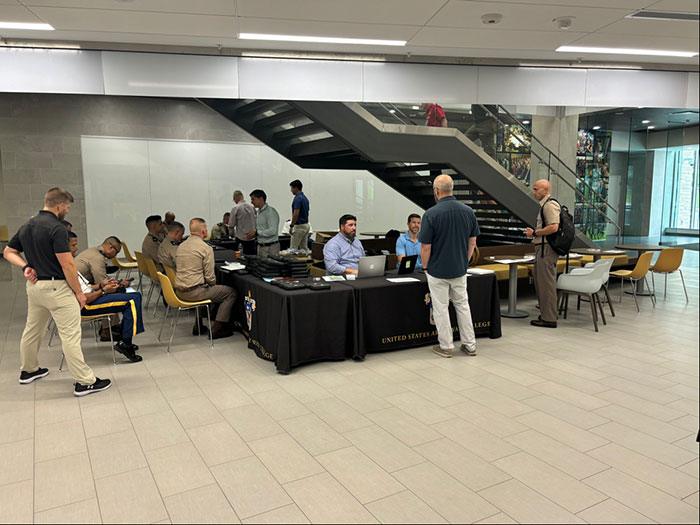MOMRP, Army War College Team Up for Wearables Pilot

FORT DETRICK, Md. – An innovative pilot project underway at the U.S. Army War College with assistance from the Medical Research and Development Command's Military Operational Medicine Research Program aims to help future senior leaders understand the benefits of smart devices for monitoring the health and well-being of the Warfighters under their command by putting wearables in their hands – or more accurately, on them.
In August, the USAWC offered over 200 Army colonels and lieutenant colonels attending the USAWC the option to participate in the project. Individuals who opted into the project were outfitted with smartwatches and smart rings supplied through MOMRP, which allow them to monitor their health, sleep and physical activity in real time using an app-based dashboard. The study's designers hope that by using the data to better understand how their behaviors, habits and choices impact their physiology and performance, the officers will return to their commands eager to demonstrate how wearables can be used to improve both unit training and overall readiness through a human performance data management system.
“We are issuing wearables to future senior military officers to expose them to the utility of this technology for understanding the wellness and well-being of their formations when they go on to their next assignments,” says Dr. Maurice Sipos, the director of USAWC's Strategic Leader Assessment and Development Program who is leading the pilot. “We understand the value of knowing operational readiness rates for vehicles. Why not have a similar metric to better understand readiness levels in your people too?”
MOMRP has partnered with Army Combat Capabilities Development Command's Soldier Center to actively explore the potential of wearables for monitoring Warfighter physiology, performance and subjective health and wellness through the DOD's Optimizing the Human Weapon System program. OHWS allows Service Members to input and monitor their own data, which is also made available to medical officers and holistic health and fitness staff. Company, battalion and brigade commanders receive aggregated data about all personnel under their command to help them formulate an overall picture of formational readiness.
Established by MOMRP and DEVCOM Soldier Center during the coronavirus pandemic, OHWS was originally intended to demonstrate that commercial off-the-shelf wearables could be used as a screening tool for COVID-19 among Service Members. Since then, OHWS has grown into a four-pronged joint force program – land, air, sea and special operations – and is actively being tested in a variety of training and operational scenarios throughout the DOD.

Joe Patterson, a Soldier Performance Strategist at DEVCOM Soldier Center, had worked with Sipos previously on a smaller-scale “mini-pilot” with 20 students in one of Sipos' elective courses. Patterson says he was eager to participate in the scaled-up pilot because it presents a unique opportunity to complement the data being obtained from units throughout the Army and the other armed services participating in OHWS testing.
“OHWS aims to link all the aspects of a Soldier's life cycle – training, education, employment and deployment – to a performance continuum,” explains Patterson. “With the Army War College, now we can bring professional military education into that continuum as well. And when the cohort graduates, they will be able to go back to their formations and lead from the front with a better understanding of the mental and physical states of their people and of themselves.”
To enable Sipos to expand the USAWC pilot, MOMRP worked with Dr. Dennis McGurk, a former director of MOMRP who, like Sipos, had served as an Army research psychologist. McGurk is a military medical research and development expert leading the North Carolina Center for Optimizing Military Performance, a consortium of academic, industry, nonprofit and government organizations.
“We tell leaders, ‘Walk around more, get to know your people,' and OHWS offers them a chance to digitally get to see their people in a way they couldn't before,” says McGurk. “It will never replace good leadership, though. It's another tool in their toolbox.”
Sipos says that in addition to providing actionable data to help people improve their health and performance, OHWS could lead to a cultural shift in the way Warfighters push the limits of their physical endurance.
“One of the goals of OHWS is to help people train smarter and not do things that could potentially hurt them in the long run,” says Sipos. “Working with people who are much better trained at designing and implementing different workout plans, for example, will go a long way toward helping prevent people from injuring themselves. The idea is to still challenge yourself, but not in a way that ends up being detrimental. It's a total mind shift.”
The USAWC pilot, Sipos believes, offers a unique opportunity to communicate that message to senior officers in a tangible, relatable way.
“For me, it's much bigger than just a watch. It's much bigger than just a ring. It's about answering the question, ‘How do we promote health and well-being across the force?'”














